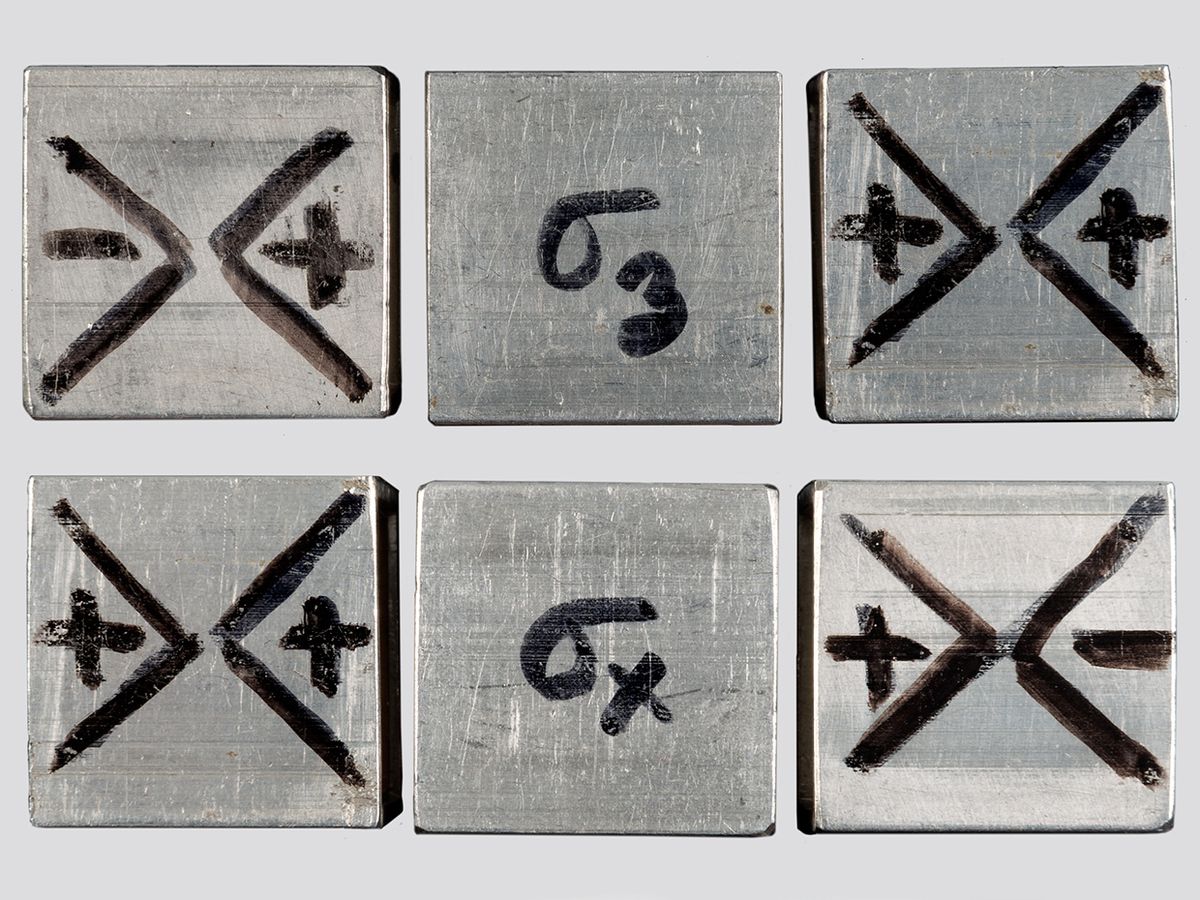In the fall of 2014, a curiosity arrived on Jean-François Gauvin’s desk. The package, simply labeled “Julian Schwinger, Phys 251a,” contained 21 aluminum cubes that were hand-marked with variations of Paul Dirac’s bra-ket notation—angle brackets and vertical bars describing quantum states. As the director of administration for the Collection of Historical Scientific Instruments at Harvard University, Gauvin had to decide whether these objects merited being added to the collection. So what were they?

The reference to Julian Schwinger was enough to grab Gauvin’s attention. The museum already had Schwinger’s Nobel Prize and Albert Einstein Award medals. Physics 251a was Schwinger’s full-year graduate course in quantum mechanics. Digging into student notes in the Harvard Archives and following other leads, Gauvin found that during the 1950s Schwinger was revising how he taught the course. Among other things, he dispensed with much of the subject’s history. Instead of working through Newtonian physics and the developmental stages of quantum, Schwinger jumped right into general algebraic laws as derived from the 1922 Stern-Gerlach experiment, in which silver atoms passed through a magnetic field and struck a detector plate, creating a discrete pattern with only two possibilities for the resulting spin measurement. The results helped convince physicists that spatial orientation of angular momentum in all atomic-scale systems was quantized. Louis de Broglie’s matter-wave theory and Erwin Schrödinger’s partial differential equation were, confusingly, relegated to the end of the course, and were dealt with only because Schwinger’s students needed to know about them for subsequent physics courses. Any reference to hypothetical cats, I suspect, was omitted.
Students recognized Schwinger’s brilliance, yet found his lectures impenetrable. Theoretical physicist and science writer Jeremy Bernstein recalled taking Schwinger’s course in 1950: “Schwinger was, it turned out, trying out an entirely new formulation of the theory on us—the old one would have been hard enough—and since he lectured from memory questions were discouraged.... After a few weeks I was lost.” In such a rigid academic environment, it was hard to imagine Schwinger using the aluminum cubes, or really any pedagogical device, to teach quantum mechanics.
How then were the cubes used? Another clue came from their provenance. The cubes had been donated to the collection by physics professor Eric Heller, who in turn had received them in the mid-1990s from Harvard physicist Costas Papaliolios. Gauvin learned that Papaliolios had taken Physics 251a with Schwinger in 1959. About three years later, Papaliolios created the cubes. His “quantum toys,” as he called them, were intended as teaching aids for a general-education course, Natural Sciences 2, which was being revised to include more historical and philosophical analysis of science.
Gauvin invited some other physicists to play with the cubes and help deduce how they were used, but it wasn’t until he found a few papers in the Papaliolios archives at Harvard that he started to understand them. The aluminum blocks were open on each end, and a polarized filter was fitted inside. Shining a light through a block, or series of blocks, yielded one of two states: The light passed through or it didn’t.

Papaliolios had been inspired to create the blocks after taking Schwinger’s course. Perhaps he struggled with the purely mathematical approach to quantum mechanics, or maybe he noticed other students struggling. While Schwinger represented the atomic measurements of the Stern-Gerlach experiment as a matrix, Papaliolios represented the two states using the polarization of light. The quantum toys were equivalent to the magnetic field of the Stern-Gerlach experiment and to Schwinger’s matrix. By reordering, adding, or omitting blocks, you could see the unique characteristics of calculations made with matrices. For example, different combinations of blocks could produce the same outcome, illustrating that different matrix representations could lead to the same quantum mechanical behavior.
The blocks came in two different sizes, 1-inch cubes and 4-inch cubes. Gauvin speculated that the larger cubes were used in lectures for demonstrations. The smaller ones are easier to manipulate and could be used by individual students. The box donated to the Harvard collection contained thirteen 1-inch cubes and eight 4-inch cubes.

As Gauvin continued researching the cubes, he saw how they fit into the history of education. Just as 18th-century orreries were used to depict the solar system, the quantum toys were a physical manifestation of an abstract concept. The cubes were also an artifact of how quantum mechanics was taught in the mid–20th century. As Schwinger was transforming his lectures, Papaliolios was attempting to make Schwinger’s impenetrable new formalism intelligible to students. During this period, Papaliolios was also involved in Harvard Project Physics, which sought to improve how high school physics was taught by adopting a more humanistic approach.
But the quantum toys proved a pedagogical nonstarter. Papaliolios never published an instruction manual for them or a paper describing their potential value in the classroom. When he lent them to colleagues or students, they were met with confusion or indifference. William Shurcliff, who was then a senior research associate at the Cambridge Electron Accelerator, disliked the symbols, complaining in a letter to Papaliolios that they were just a jumble of numbers, letters, and arrows. John Major Fowler, a visiting professor at the University of Maryland who was interested in improving science teaching, returned the toys to Papaliolios after several months without ever using them in his lecture demonstrations of quantum mechanics. The box of toys was quietly forgotten until it made its way to the museum.
When I learned of Gauvin’s investigation, which he described in a recent paper in Physics in Perspective, I was immediately intrigued. I mean, when’s the last time you saw a museum object related to quantum mechanics? I was also drawn to the name, quantum toys, because it inspired so many possibilities in my mind. I liked the fact that the toys reflected debates over how much history should be incorporated into science curriculum, and the question of play in the teaching of science.
I also was struck by the fact that Papaliolios created the toys to teach basic aspects of quantum mechanics to nonphysics students. Clearly, he felt the average person should know something about this arcane subject. But does being an informed citizen really require a familiarity with quantum mechanics? This is a serious question. In May, a Wall Street Journal commentary suggested that high school students don’t need to study calculus and should instead study statistics and probability. This naturally led to an angry chorus of comments and letters to the editor singing the praises of math. But if calculus is on the chopping block, what is the expectation for quantum mechanics?
The journal in which Gauvin published his research, Physics in Perspective, claims to “bridge the gulf between physicists and non-physicists through historical and philosophical studies,” and yet I found myself struggling through some of the article’s technical descriptions. Unable to recall long dormant knowledge from my college studies, I turned to Wikipedia, which also failed to enlighten me. One entry began with the disclaimer “This article assumes familiarity with the standard Lagrangian and Hamiltonian formalisms, and their connection to canonical quantization.” I, unfortunately, lack such familiarity.
Which gets back to the question: What should be our baseline understanding of quantum mechanics? These days, for those with the time and the inclination, there are plenty of opportunities to learn at least the basics. Shini Somara, an engineer and science communicator, introduces quantum mechanics in two episodes of the PBS YouTube series Crash Course Physics. Here’s the first episode:
Collectively, the two episodes have garnered over a million views. Quantum mechanics also shows up in The Great Courses, including a series dedicated to Particle Physics for Non-Physicists, while MOOCs (massive open online courses) on the subject include edX’s Quantum Mechanics for Everyone.
Contrary to Schwinger’s approach to teaching, these modern courses are grounded in the historic development of physics—Newton, de Broglie, and Schrödinger (and his poor cat) are back. And yet they stop well short of embracing Papaliolios’s approach; you won’t learn about matrix manipulation or have any tactile interaction with abstract thoughts. In the current zeitgeist, it seems, popular understanding of quantum involves broad principles but little math.
Perhaps the time is finally ripe for Papaliolios’s quantum toys. While researching his article, Gauvin found himself “hypnotized” by the curious cubes. In an email to me he wrote,
“The more I played with them, the more I understood them, the more brilliant I thought the idea was. But they are indeed not easy to use and not easy to understand.... I don’t think anyone could really understand the basics of quantum mechanics simply by [playing with] a set of these cubes. But once you know the principles of two-state systems, they become fascinating playthings. In short, I’ve rarely had so much fun and so much hands-on approach in writing a paper.”
Gauvin’s article includes an appendix with detailed instructions for making your own set of quantum toys. I know that for me, reading about quantum mechanics or listening to lectures is not enough. I plan to go build some toys and play.
An abridged version of this article appears in the August 2018 print issue as “A Quantum of Play.”
Part of a continuing serieslooking at photographs of historical artifacts that embrace the boundless potential of technology.
About the Author
Allison Marsh is an associate professor of history at the University of South Carolina and codirector of the university’s Ann Johnson Institute for Science, Technology & Society.
Allison Marsh is a professor at the University of South Carolina and codirector of the university's Ann Johnson Institute for Science, Technology & Society. She combines her interests in engineering, history, and museum objects to write the Past Forward column, which tells the story of technology through historical artifacts.



